Kentucky Pesticide Safety Education Program

Questions?
Contact
Dr. Ric Bessin
Dept. of Entomology
University of Kentucky
859-257-7450
rbessin@email.uky.edu
Plant Diseases
A plant disease is any harmful condition that affects a plant’s appearance or function. Common pathogens that cause diseases include: fungi, bacteria, and viruses. Some nematodes are plant disease agents. Temperature extremes or nutrient deficiencies are examples of disorders caused by non-infectious factors.
The disease triangle is a fundamental concept in plant pathology. Disease occurs only when all three sides of the triangle are present: a susceptible host, a pathogen (the agent that causes disease), and an environment favorable for disease to develop. Plant diseases are managed by manipulating the disease triangle: the plant, the pathogen, and/or the environment.
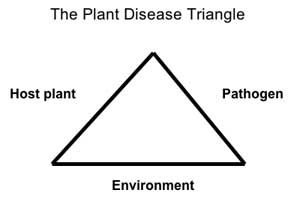
Infection begins when the pathogen enters the plant. The disease process starts when it arrives at a part of a plant where infection can occur. If environmental conditions are favorable, the pathogen begins to develop. The plant is diseased when it responds.
Plants respond to disease in 3 main ways:
- overdevelopment of tissue - galls, swellings, or leaf curls;
- underdevelopment of tissue - stunting, lack of chlorophyll, or incomplete development of organs; or
- tissue death - blight, leaf spot, wilting, and cankers.
Plant disease pathogens may be spread in many ways:
- by wind;
- rain;
- animals;
- soil;
- nursery grafts;
- vegetative propagation;
- contaminated equipment and tools;
- infected seed stock;
- pollen;
- dust storms;
- irrigation water; and
- people.
Infectious Organisms that Cause Diseases
Fungi are the most common infectious organisms causing plant disease. They do not have chlorophyll so they cannot make their own food. They must get it by living on another organism.
Most fungi are beneficial. They contribute to soil fertility by releasing nutrients from dead plants or animals. Those that cause plant diseases are parasites on living plants. They may attack plants and plant products both above and below ground. Some fungal pathogens attack many plant species; others have to only one host species.
 Most fungi reproduce by spores, which function like seeds. Fungus spores are often microscopic and are produced in tremendous numbers. Often spores can survive for weeks, months, or even years without a host plant. Excessive water or high humidity is nearly always needed for spore germination and active fungal growth.
Most fungi reproduce by spores, which function like seeds. Fungus spores are often microscopic and are produced in tremendous numbers. Often spores can survive for weeks, months, or even years without a host plant. Excessive water or high humidity is nearly always needed for spore germination and active fungal growth.
Spores can spread from plant to plant and crop to crop through wind, rain, irrigation water, insects, and by people through infected clothing and equipment.
Fungal infections frequently are identified by the vegetative body of the fungus (mycelium) and the fruiting bodies that produce the spores. Often, they are large enough to see.
Symptoms of fungal infections include
- soft rot of fruits,
- plant stunting,
- smuts,
- rusts,
- leaf spots,
- wilting, or
- thickening and curling of leaves.
Powdery and downy mildew, smut, root and stem rots, and sooty and slime molds are examples of fungus diseases.
Bacteria are single-celled organisms that usually reproduce by simple cell division. Some divide as often as every 30 minutes. They can build up quickly under warm, humid weather conditions. Leaf, growing shoots, and fruit diseases are the most common types in Kentucky.
Bacteria can be carried from plant to plant in water droplets, by wind, rain splash, insects, or on equipment. They often survive between growing seasons in crop residue, in seeds or cuttings, or in weeds.
Leaf Diseases Caused By Fungi and Bacteria
Leaf Spots
Bacteria or fungi can cause leaf spots that vary in size, shape, and color. Usually the spot has a distinct margin and may be surrounded by a yellow halo. A fungal leaf spot nearly always has a growth of some type in the spot, particularly in damp weather. It may be a tiny pimple-like structure or a moldy growth of spores. Often the structures are visible through a hand lens. Nearby diseased areas may join to form irregular "blotches."
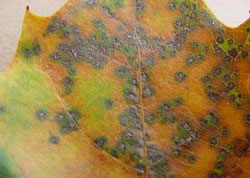
photo: Paul Bachi, University of Kentucky Research and Education Center, Bugwood.org
Septoria brown spot is a common fungal disease of soybeans. It causes small angular red-brown spots to develop on upper and lower surfaces of trifoliate leaves 2 to 3 weeks after planting. Numerous spots will cause leaves to yellow and drop. The disease will develop many irregular, tan lesions on trifoliate leaves that later turn dark brown. Individual spots will frequently coalesce to form large blackish-brown blotches.
Defoliation from the bottom to the top of severely diseased trifoliate leaves is common during wet seasons. Early season brown spot will appear annually in almost every field in Kentucky. Late-season brown spot is much more variable in occurrence and severity.
The fungus survives from season to season in crop debris and seed. Warm, moist weather promotes the sporulation of the fungus; the spores are spread by wind and rain. Hot, dry weather can stop disease development.
Leaf Blights
Leaf blights generally affect larger leaf areas and are more irregular than leaf spots.
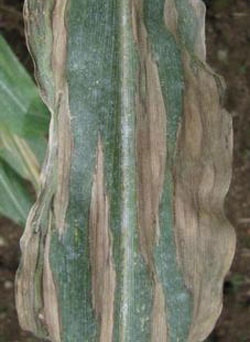
photo: Margaret McGrath, Cornell University, Bugwood.org
Northern corn leaf blight (NCLB), caused by a fungus, first develops on the lower leaves of corn plants that are from waist to shoulder high. The telltale sign of northern corn leaf blight is the 1-to-6 inch long cigar-shaped gray-green to tan-colored lesions on the lower leaves. As the disease develops, the lesions spread to all leafy structures.
Wet weather and moderate temperatures favor NCLB. Symptoms can be confused with bacterial wilt, especially late in the season.
NCLB will be more severe in fields with corn following corn under reduced tillage. Other hosts include sorghum, Johnsongrass, and some other grass species. The pathogen overwinters in plant debris and is transferred by wind to new plants. Severe yield loss can occur when leaves become blighted during early grain fill.
Rusts
Rust fungi often produce bright yellow, orange-red, reddish-brown or black "pustules". The pustules are usually raised above the leaf surface. Rust can be rubbed off the leaf surface.
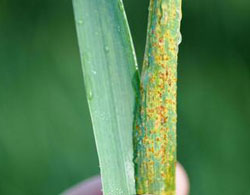
photo: Donald Groth, Louisiana State University AgCenter, Bugwood.org
Powdery Mildews
Powdery mildews are diseases caused by some closely related fungi. The mildew can be diagnosed by a grayish white powder mat leaves and in some cases stems. Affected leaves usually turn yellow, wither and die rapidly.
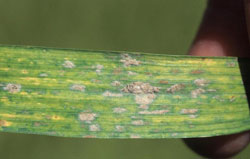
photo: Gerald Holmes, California Polytechnic State University at San Luis Obispo, Bugwood.org
Powdery mildew of wheat is easily diagnosed by the white, powdery patches that form on the upper surfaces of lower leaves and stems. The patches turn a dull gray-brown and may have small black embedded specks. This disease can spread to all aboveground parts of the plant.
The fungus responsible for powdery mildew can persist between seasons in infested wheat stubble and in overwintering wheat. Spores then infect plants during periods of high moisture (not necessarily rain) and cool to moderate temperatures. Low light intensity, which accompanies dreary weather, and a dense, lush crop canopy favor this disease. Hot daytime temperatures (80°F plus) and moderate nighttime temperatures will stop powdery mildew development.
Downy Mildews
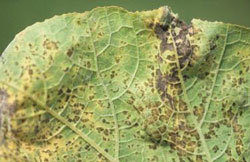
photo: Gerald Holmes, California Polytechnic State University at San Luis Obispo, Bugwood.org
Wilts, Root and Crown Rots
The main symptoms of these three diseases are wilting, stunting, and death. The causal organisms are usually soil-borne, that is they are already present in the soil when the host crop is planted. Most other diseases are usually spread through the air. Some of these diseases may be controlled through the use of soil fungicides and/or soil fumigants but most are controlled with resistant varieties and cultural practices. Good controls are not available for many of these diseases.
Wilts
Most wilt diseases are caused by fungi -- Fusarium and Verticillium -- and a bacterium, Erwinia. Each parasite causes wilts on a wide range of crop plants. A light to dark brown streaking often can be seen when the stem of a diseased plant is cut lengthwise. However, it is often difficult to determine which of these wilt diseases a plant may have.
Plants with Fusarium or Verticillium wilt grow slower than healthy plants and may show stunting effects before wilting occurs. The lower leaves usually turn yellow and wilt first, then yellowing and wilting slowly progress up the plant. It may take several days to a few weeks from first wilting and plant death.
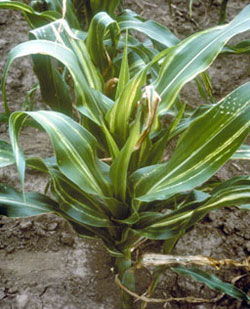
photo: J.K. Pataky, University of Illinois at Urbana-Champaign, Bugwood.org
Stewart’s wilt of corn is a bacterial disease with two phases. The seedling wilt stage occurs when young plants have a systemic infection. The leaf blight stage occurs when plants are infected after the seedling stage. The bacterium spends the winter in the corn flea beetle. The bacterium enters the plant at wounds made when an infected flea beetle feeds on a susceptible plant.
Stewart's wilt is controlled effectively by planting resistant corn hybrids. Resistance restricts the movement of bacteria in the vascular system of plants and prevents plants from becoming infected systemically. Most field corn hybrids are moderately to highly resistant; sweet corn hybrids range from highly susceptible to resistant.
Crown Rots
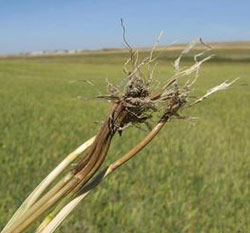
photo: Ernesto Moya, Bugwood.org
Crown rots include causal organisms that attack the plant at/or near the soil line. Crown rots are called various names such as collar rot, stem blight, stalk rot and southern blight. Affected plants are generally, at first, unthrifty with leaves smaller and lighter green than normal. Leaves usually turn yellow and, in advanced stages of disease, wilt and die. The crown or base of the stem will be water-soaked, discolored or decayed. With some diseases, this area may dry rot and become shredded. A moldy growth and various colored fungus fruiting bodies often form in this diseased area.
Most crops are affected by one or more of this type of disease.
Root Rots
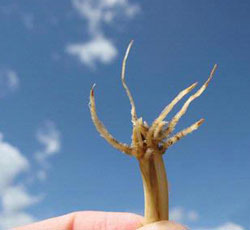
photo: Mary Burrows, Montana State University, Bugwood.org
A great variety of fungi can infect the crown of the alfalfa plant, which is the portion of the taproot just below the soil line. The alfalfa plant stores food reserves for winter in the crown. Crown rot diseases interfere with this process, making plants more susceptible to winter injury.
Seed and Seedling Diseases
Seed and seedling diseases occur on plants from after germination until about 1 or 2 weeks after seedling emergence. Fungi that are on the seed at planting or are present in the soil are the cause. They often are responsible for poor emergence and thin stands.
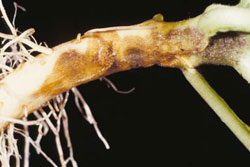
photo: Paul Bertrand, University of Georgia, Bugwood.org
If the disease occurs before emergence, the seedling may rot before it has a chance to get out of the soil. This is referred to as pre-emergence damping-off. After emergence, seedling stems may be attacked at or below the soil line in what is termed post-emergence damping-off.
Two general symptoms are brown to red-brown or black cankers at the soil line and a soft watery rot. If the canker girdles the stem, the seedling falls over and dies. The plant may continue to live but will be stunted with partial girdling, In the second instance, the soft watery rot continues until the entire seedling decays.
Seed and seedling diseases are most common in cool, wet soils. They are controlled by planting crops in warm soil, by fungicide seed treatments and by use of in-furrow, broadcast, or band-applied fungicides.
Smuts
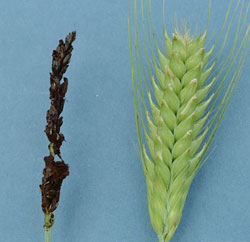
photo: Clemson University - USDA Cooperative Extension Slide Series, Bugwood.org
Viruses
Viruses are too small to be seen with a microscope. They are generally recognized by their effects on plants. There can be a variety of responses: stunted growth; change in plant color; abnormal formation of infected roots, stems, leaves, or fruit. Mosaic diseases, characterized by light and dark blotchy patterns, usually are caused by viruses.
It can be difficult to distinguish between diseases caused by viruses and those caused by fungi and bacteria. A positive diagnosis requires sophisticated testing, such as inoculating indicator plants and observing the results or using specifically identified antibodies to test for the presence of the organism.
Viruses depend upon living organisms for food and reproduction; they cannot exist very long outside a host. Viruses are commonly spread from plant to plant by mites, aphids, leafhoppers, or whiteflies. A few are spread in the seeds of the infected plant.
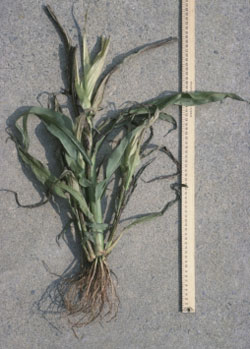
photo: Mary Ann Hansen, Virginia Polytechnic Institute and State University, Bugwood.org
Maize Dwarf Mosaic Virus (MDMV) and Maize Chlorotic Dwarf Virus (MCDV) can survive between crops in underground rhizomes. MCDV is moved between corn, Johnsongrass, and sorghum by leafhoppers. Symptoms only appear in corn. MDMV, carried by aphids, infects over 250 species of grasses.
Nematodes
Nematodes are small, usually microscopic roundworms with mouthparts like hollow needles – called stylets. Stylets are used to puncture and feed on the contents of plant cells. Nematodes may develop and feed inside or outside of a plant. They are easy spread on footwear, tools, and equipment.
The life cycle of a nematode includes an egg, several larval stages, and an adult. Most larvae look like small adults. In unfavorable conditions, females of some species form inactive, resistant forms called cysts. The cyst is the hard, leathery, egg-filled body of the dead female, which is difficult to penetrate with pesticides. A cyst may protect eggs for as long as 10 years.
Typical aboveground symptoms are stunting, yellowing, loss of vigor, general decline, and eventual death of plants. Since many other problems can cause symptoms root and soil samples need to be examined when nematode injury is suspected. Nematodes are controlled with cultural practices such as crop rotation, resistant varieties and nematicides.
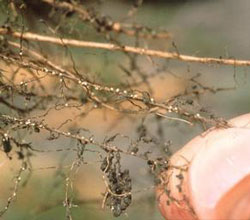
Cysts (bodies of female nematodes) are visible on diseased roots from four weeks after planting through the rest of the season
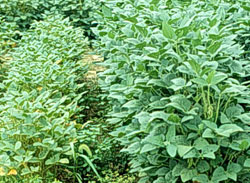
SCN-affected plants (left) vs. unaffected plants (right)
photos: Paul Bachi, University of Kentucky Research and Education Center, Bugwood.org
In Kentucky, the soybean cyst nematode (SCN) is the most damaging nematode disease. It feeds on the roots of soybean and other host plants. Feeding removes nutrients and disrupts nutrient and water movement. An infestation also reduces the production of nitrogen-fixing nodules and encourages other root diseases.
SCN in Kentucky
- Causes up to 30% yield loss without any obvious problem until harvest.
- Eggs can survive in the soil for many years even without host plants.
- Reproduction occurs on resistant soybeans.
- Moves every way that soil moves.
- SCN can be present in a field for many years before it is detected.
- Symptoms may look like those due to other causes.
Diagnosis of Plant Diseases
A correct diagnosis is the first step in disease management. To recognize a disease condition, you must know the plant's normal growth habits. When you are trying to identify the cause of a plant disease, you need to look for symptoms - the host plant's reaction to the disease agent, and signs - visible presence of the disease agent.
Many different plant diseases cause similar symptoms. Different pathogens and agents that are not pathogens can cause leaf spots, wilts, root galls, or stunted growth. For example, similar symptoms may be a result of mechanical injury, improperly applied fertilizers and pesticides, or frost. Often, the only way to pinpoint the cause is to find the observable signs that the particular disease agent is present -such as fungal spores and mycelium or bacterial ooze.
[return]
1) Which of the following causes a plant disorder?
2) _________ are the most common infectious organisms causing plant disease.3) _________ reproduce by spores.
4) _________ reproduce by simple cell division.
5) _________ is an example of a fungal disease.
6) ________ diseases are commonly spread by aphids or leafhoppers.
7) Wilting is an example of a disease sign.
8) Infection begins when the pathogen ___________.
9) _________ move from plant to plant on in water droplets, rain splash, or being carried by insects.
10) Powdery mildew, root rots, and stem rots are examples of diseases caused by __________.
11) __________ causes small angular red-brown spots on trifoliate soybean leaves 2 to 3 weeks after planting.
12) Northern corn leaf blight overwinters in __________.
13) _________ diseases usually produce pustules on plant leaves.
14) Leaf rust is rarely is an explosive problem because it develops so slowly.
15) _________ is the first step in disease management.
16) Many different plant diseases cause similar symptoms.
website content by L. Townsend website design by P. Dillon copyright © 2016 University of Kentucky Department of Entomology
University of Kentucky College of Agriculture |
S-225 Agricultural Science Center North, Lexington, KY 40546-0091 | 859.257.7450
An Equal Opportunity University |
Last modified
11/30/2018
